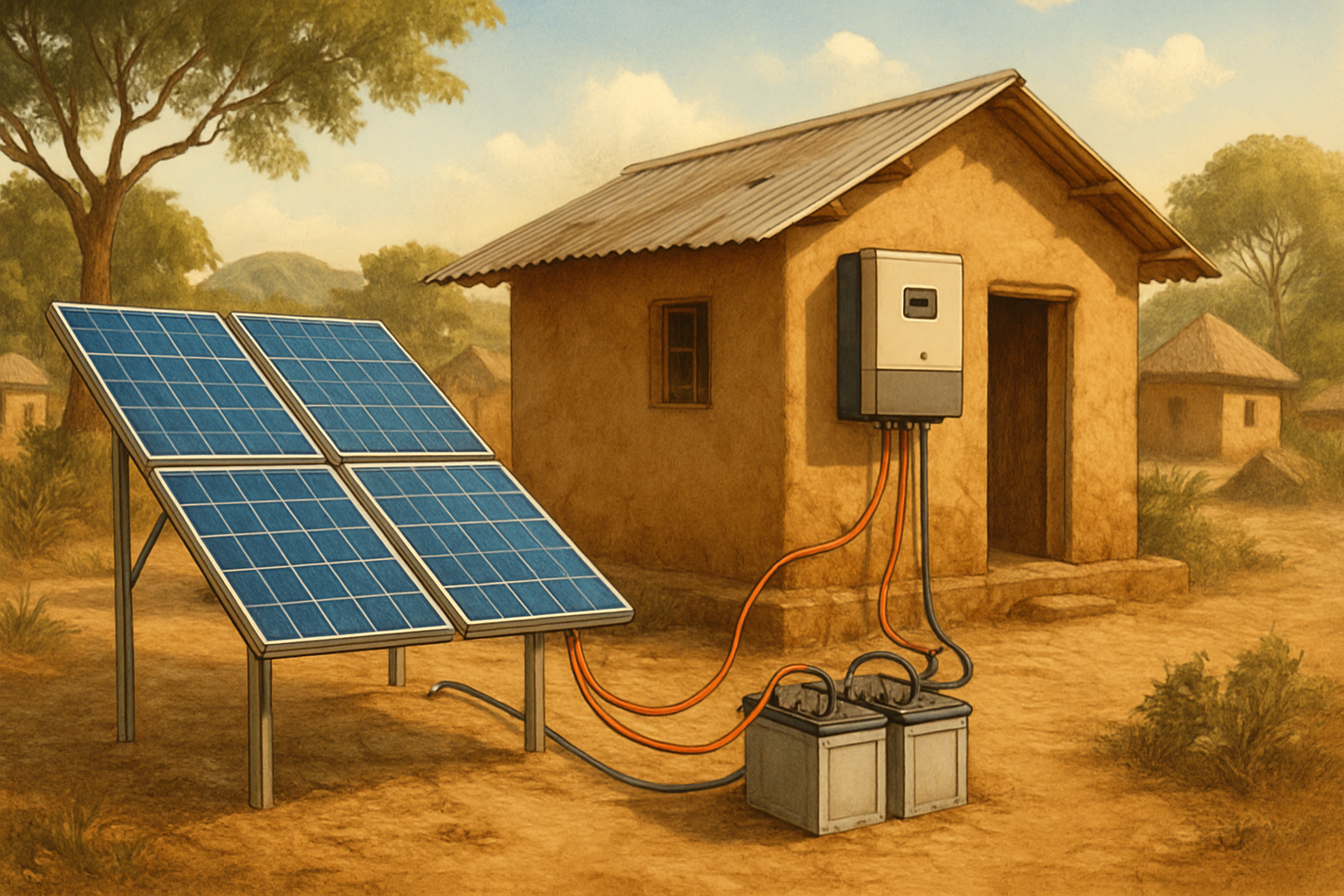Access to consistent, reliable electricity remains a significant challenge for many remote communities globally. Schools in these areas often struggle with intermittent power or no power at all, severely limiting educational opportunities. Imagine a learning environment where lights flicker, computers sit idle, and essential resources like refrigeration for vaccines are unavailable. Off-grid solar microgrids offer a powerful solution, promising to deliver dependable, round-the-clock electricity. This approach transforms how remote schools operate, fostering better learning outcomes and stronger communities.

The Energy Access Gap and Its Impact on Education
Millions of people worldwide still lack access to reliable electricity grids. This energy deficit disproportionately affects remote villages and rural areas, where extending traditional grid infrastructure proves economically unfeasible. The absence of electricity creates a ripple effect, impacting every aspect of community life, especially education.
Challenges Faced by Remote Schools
Without consistent power, schools in remote communities face numerous hurdles. Evening study becomes difficult, limiting students' ability to complete homework or engage in extracurricular activities. Technology integration, a cornerstone of modern education, is impossible without electricity. This widens the educational gap between urban and rural students. Furthermore, basic amenities like clean water (often requiring pumps) or proper sanitation can be compromised, affecting student health and attendance.
Limitations of Traditional Power Sources
Historically, remote schools might rely on diesel generators for electricity. While these provide power, they come with substantial drawbacks. Fuel costs are high and volatile, requiring constant procurement and transportation to often inaccessible locations. Diesel generators also produce noise pollution and harmful emissions, contributing to poor indoor air quality and environmental degradation. The International Energy Agency (IEA) highlighted in 2006 that fuel-based lighting is expensive, inefficient, and causes thousands of deaths annually from respiratory and cardiac problems related to poor indoor air quality. These limitations make diesel an unsustainable long-term solution for educational facilities.
How Off-Grid Solar Microgrids Provide 24/7 Power
Off-grid solar microgrids are self-contained energy systems designed to operate independently from the main electrical grid. They harness solar energy, store it, and distribute it to connected loads, ensuring a continuous power supply. This technology is particularly well-suited for providing reliable electricity to schools in remote locations.
Key Components and Their Functions
A typical off-grid solar microgrid comprises several essential components:
- Solar Panels: These convert sunlight into direct current (DC) electricity. Their efficiency and durability have improved significantly over the years.
- Battery Energy Storage Systems (BESS): Batteries store excess solar energy generated during the day for use at night or during cloudy periods. Our company specializes in high-performance, safe, and reliable Lithium Iron Phosphate (LiFePO4) batteries, which are ideal for such applications due to their long cycle life and stability.
- Hybrid Inverters: These devices convert the DC electricity from solar panels and batteries into alternating current (AC) electricity, which is what most school appliances and electronics use. Advanced inverters also manage the flow of power, optimizing energy usage and system stability.
- Charge Controllers: These regulate the voltage and current from the solar panels to the batteries, preventing overcharging and extending battery lifespan.
- Control Systems: Sophisticated control systems monitor and manage the entire microgrid, ensuring efficient operation, fault detection, and seamless power delivery.
The integration of these components allows the microgrid to function as a resilient and independent power source. Microgrids are small electric grids that can operate while disconnected from the main grid, often using solar energy and batteries to work independently.
The Role of Energy Storage for Continuous Reliability
Battery storage is the cornerstone of a 24/7 off-grid solar microgrid. Solar panels only generate electricity when the sun shines. To provide power during evenings, nights, or periods of low sunlight, the system must store energy. Our integrated ESS solutions combine lithium batteries with hybrid inverters and solar panels, creating a cohesive system that ensures consistent power availability. This allows schools to operate computers, power lights for evening classes, and run essential equipment without interruption. The International Renewable Energy Agency (IRENA) notes that implementing more storage capacity in mini-grids can drastically reduce fossil fuel consumption and increase the share of variable renewable energy, aiding the transition to 100% renewable electricity generation in off-grid areas.
Benefits and Real-World Applications for Educational Settings
Deploying off-grid solar microgrids in schools brings a multitude of benefits, extending beyond mere electricity provision to positively impact education, community resilience, and economic development.
Enhancing Educational Outcomes and Community Resilience
Reliable electricity transforms the learning environment. Students gain access to digital resources, improving their literacy and technical skills. Extended school hours become possible, offering more time for instruction and extracurricular activities. The Oglala Lakota College project, for example, used an off-grid system to provide power for electric tools and community service projects, demonstrating how such systems can spread impact throughout a wider community. Microgrids also enhance community resilience, providing a stable power supply for critical facilities like schools, which can double as community hubs during emergencies when the main grid fails. This capability is vital for maintaining essential services and communication.
Economic and Environmental Advantages
The economic benefits of off-grid solar microgrids are substantial. While the upfront capital investment for renewable technologies can be higher, the operational costs are significantly lower compared to diesel generators. IEA data from 2024 indicates that renewable microgrids are cheaper to operate than diesel-based ones, with levelized costs of 0.40-0.61 USD/kWh compared to diesel’s 0.92-1.30 USD/kWh. This long-term cost saving frees up school budgets for other educational needs. Environmentally, these systems drastically reduce carbon emissions and air pollution, contributing to cleaner air and a healthier planet. This aligns with global efforts to combat climate change and promotes a sustainable future for students.
Designing and Implementing a Reliable Off-Grid System
Successful implementation of an off-grid solar microgrid for a school requires careful planning, appropriate technology selection, and ongoing maintenance. Our company brings years of experience in the solar and energy storage industry, offering reliable and scalable energy solutions.
System Sizing and Component Selection
Accurate system sizing is crucial. This involves assessing the school's energy needs, including lighting, computers, fans, and any other electrical appliances. Factors like peak demand, daily energy consumption, and desired autonomy (how long the system can run without sun) inform the size of the solar array and battery bank. Selecting high-quality components, such as our LiFePO4 batteries and integrated ESS, ensures system longevity and performance. For instance, a microgrid in Chile, mentioned in an IRENA report, combines a 125 kW-peak solar PV facility with 582 kWh of energy storage, providing 24 hours of clean energy without diesel backup.
Maintenance and Long-Term Operation
While off-grid solar systems are robust, regular maintenance ensures optimal performance. This includes cleaning solar panels, checking battery health, and monitoring inverter operation. Training local personnel to perform basic maintenance tasks empowers the community and ensures the system's long-term viability. Our company focuses on developing integrated solutions that are not only high-performing but also user-friendly, simplifying operation and maintenance for remote users.
Empowering Education with Sustainable Energy
Off-grid solar microgrids represent a transformative solution for providing 24/7 power to schools in remote communities. They address the critical energy access gap, replace costly and polluting fossil fuels, and create environments conducive to learning and growth. By embracing these sustainable energy solutions, we empower students with the tools they need to succeed, foster resilient communities, and contribute to a cleaner future. The proven track record of mini-grid technology, with over a decade of reliable operations in demanding conditions, underscores its readiness for widespread adoption.
Frequently Asked Questions
What are the primary benefits of off-grid solar microgrids for schools?
Off-grid solar microgrids provide reliable, clean, and cost-effective electricity, enabling 24/7 power for lights, computers, and other educational tools. They reduce reliance on expensive and polluting diesel generators, improve air quality, and enhance community resilience by providing a stable power source during outages.
How long do off-grid solar microgrid batteries typically last?
The lifespan of batteries in an off-grid solar microgrid depends on the type and quality of the battery, as well as usage patterns. Lithium Iron Phosphate (LiFePO4) batteries, which our company manufactures, are known for their high performance, safety, and long cycle life, often lasting 10-15 years or more with proper management.
Can off-grid solar microgrids support all the power needs of a school?
Yes, with proper design and sizing, off-grid solar microgrids can be tailored to meet all the power requirements of a school, from basic lighting and ventilation to computer labs, administrative offices, and even specialized equipment. Accurate energy assessment is key to ensuring the system can handle peak loads and provide continuous power.
Is it difficult to maintain an off-grid solar microgrid system?
Modern off-grid solar microgrid systems are designed for reliability and require relatively low maintenance. Regular tasks include cleaning solar panels and periodic checks of battery and inverter performance. Training local staff for basic maintenance helps ensure the system's long-term efficiency and operation.





Leave a comment
All comments are moderated before being published.
This site is protected by hCaptcha and the hCaptcha Privacy Policy and Terms of Service apply.